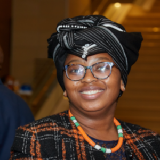Blog
Unless otherwise stated, content is shared under CC-BY-NC Licence
FDO2022 Conference – human and social factors in data and metadata management
Louise Preston is a Project Officer at the National Archives of Australia. She attended FDO2022 with support from the DPC Career Development Fund, which is funded by DPC Supporters.
Writing systems developed in Mesopotamia and other ancient societies to manage information because human memory simply could not store all information. It was a new and specialised field that began with only partial script. As writing and recording became more complex, the amount of information stored grew, becoming difficult to find and retrieve. Ancient scribes learnt to use catalogues, dictionaries, tables, forms and calendars to access and retrieve information (Harari, Yuval Noah, Sapiens, 2015).
Today, we are still grappling with how to manage and retrieve information but with the additional tier of machines to store our information. We have developed inexorably large repositories to store vast amounts of digital information kept in different formats in different systems. The 1st International Conference on FAIR Digital Objects (FDO2022), held from 26 to 28 October in Leiden, Netherlands, hosted by the Fair Digital Objects (FDO) Forum, focused on how to apply the FAIR (Findable, Accessible, Interoperable, Reusable) guiding principles to managing that increased volume and complexity using computational systems. The principles, which apply to data, metadata and the infrastructures maintaining them, were developed in Leiden for the management and stewardship of scientific and scholarly data and published in 2016 (Wilkinson et al., 2016). An international set of principles, they do not prescribe any technology, standard or implementation method.
If this file format has a risk score of 42, what was the question? And what does ransomware score?
Last Thursday I took part in an OPF panel debate "Do unacceptable file formats exist?" It was great fun to debate file format policies and preservation approaches with Valentijn Gilissen from DANS. And we had amazing moderation from Sam Alloing who had to get to grips with a text chat that exploded out of control as 200 audience members all dived in with loads of fascinating insight. The exported text chat was 50Kb long!
Message in a Bottle - More N2KH is On Its Way!
Email continues to be one of the most commonly used communication methods for business and personal purposes. Therefore, capturing a complete record of our interactions, of planning, and of decisions made, both in the recent past and for the foreseeable future, must include the preservation of email. If this is to happen it is imperative that the archives sector upskill to meet that challenge. It was with this in mind that The National Archives (UK)
has chosen email preservation as the focus for the latest training course in the “Novice to Know-How” (N2KH) series.
Designated communities - a disconnect between theory and practice?
Our last DPC event of 2022 was a #DPClinic session on the topic of Designated Communities. The event began with a brief introduction from Herve L’Hours and was followed by a lively and interesting community discussion. Often our #DPClinic topics are generated by the community, but this one was my own idea. I had a particular interest in organizing this session as I had been doing some work on this topic and had some questions in my own mind that I wanted to discuss. I understood the theory of designated communities (which originates from the OAIS Reference Model) but what I really wanted from this session was to understand how this theory translates into practice.
FAIR Digital Objects 2022 Conference – Challenges with terminology
Zoë Hollingworth is Collections Systems Lead at V&A South Kensington and part-time PhD student in History of Art at the University of Edinburgh. She recently attended FDO2022 with support from the DPC Career Development Fund, which is funded by DPC Supporters.
With a grant from the Digital Preservation Coalition, I was fortunate enough to attend the 1st International Conference of FAIR Digital Objects (FDO2022) held in Leiden, Holland, 26th to 28th October 2022. The conference was hosted by the Fair Digital Objects (FDO) Forum, which hopes to ‘achieve a better coherence amongst the increasing number of initiatives working on FDO-based designs and implementations.’
Reimagining the digital preservation workflows of Archives - FIAT/IFTA World Conference 2022
Thandokazi Maceba is a Data Curation Officer at the Libraries of the University of Cape Town (UCT). She recently attended The FIAT/IFTA World Conference 2022 in Cape Town, with support from the DPC Career Development Fund, which is funded by DPC Supporters.
I discovered the FIAT/IFTA World Conference 2022 at a time in my career when I was searching for ways to improve my skills set and broaden my scope in the Library and Information Sciences sector. I like the fact that it was happening in Cape Town, and I could learn international industry best practices, and create local and international networks in the comfort of my city.
I am a Data Curation Officer in the Digital Library Services department of the Libraries at the University of Cape Town. As part of my role, I strive to enhance preservation and access processes and workflows for the preservation and access of the libraries and other collections across campus. This is accomplished by utilising the appropriate software, scripts, or tools for data transformation and manipulation and by logically organising a range of file formats for access and preservation.
DPClinic – Behind the scenes with Barbara Sierman
Michael Popham is Digital Preservation Analyst at the DPC.
For this month’s DPClinic, Barbara Sierman chose to reprise a session she offered at the recent iPres 2022 conference. Barbara is well-known to many in the digital preservation community, having worked formerly as Digital Preservation Manager at the Koninklijke Bibliotheek (National Library of the Netherlands), and since being awarded a DPC Fellowship in 2018 in recognition of her sustained personal contribution to digital preservation.
Barbara is currently writing a book about her time working in digital preservation, in which she plans to pay tribute to the pioneers in the field. Barbara confessed that in the course of her research, she has been surprised at just how long some people have been working on aspects of digital preservation that still engage our thinking today. She was keen to hear others’ thoughts and reflections on these topics, and chose to do this by presenting citations from five seminal pioneers of digital preservation from Australia, Canada, UK, US, and the Netherlands.
File format recommendations - I wouldn’t say they are unacceptable, but I wouldn’t recommend them either
Last week I joined a webinar entitled “A Comparison of Recommended File Formats and the New Dutch Method for File Format Assessment”. It’s great to see the outcomes of this collaborative work, and it’s clear that it has already played an important role in bringing out some key themes in the preservation approaches of various organizations. But I felt that a number of aspects give cause for concern. The collation of file format policies has highlighted some approaches that I believe should be challenged and discussed further. I also suggest that the communication of the work could be enhanced to avoid misleading readers and propagating potentially poor preservation practice. These are of course just my thoughts on this topic, but I’d love to continue the conversation and try to better understand the motivation around these approaches to addressing file formats.
Tapping the (Open) Source – No Time To Wait 2022
Nigel Bryant is Audiovisual Digitisation Officer at the University of Bristol Theatre Collection. He recently attended No Time To Wait 6 with support from a travel grant from the DPC Career Development Fund, which is funded by DPC Supporters.
As part of my role, I am constantly striving to improve processes and workflow for the preservation of AV materials. I am currently implementing an open source workflow employing the Matroska (.mkv) video format, ideally using entirely Free and Open Source Software (FOSS). Matroska is a purpose-built multimedia wrapper that carries a variety of payloads including video, audio, subtitles and metadata. In combination with the FFV1 codec, Matroska files can hold losslessly compressed video which is visually identical to uncompressed video. This combination has been adopted as the AV preservation format of choice for many institutions including the British Film Institute.
Notes After Attending the 2022 FIAF Film Restoration Summer School
Natalia Bianchi is a Digitisation Technician working with time-based media in the Access Team at Imperial War Museum. She attended the FIAF Film Restoration Summer School this year with support from the DPC Career Development Fund, which is funded by DPC Supporters.
Even if film archives and cultural heritage institutions around the world are aware of the comprehensive film preservation policies that should be put in place, many analogue film collections are slowly deteriorating over the years due to a lack of resources and unfavourable climate conditions, among other reasons. In this context, thinking about strategies of mass-digitisation programmes and long-term digital preservation is therefore fundamental for future generations and the protection of the audio-visual heritage.





















































































































































